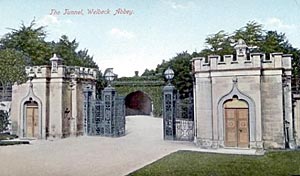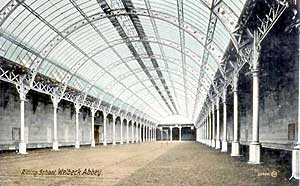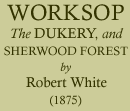< Previous | Contents | Next >

The Tunnel, Welbeck Abbey.
One of the most extraordinary works has been the formation of a subterranean road-way through a portion of the park and under the lake, in place of an ancient highway which existed before it. It is arched with bricks, and lighted from the top by circular lights of polished plate-glass, 12-inch thick and twelve yards apart, with intermediate gas-lights, which are used night and day to ensure safety to passengers through it. With the noble Duke’s usual thoughtfulness, he has placed a drinking fountain under the subterranean road-way, to take the place of the "Welbeck Ale," which was formerly at the command of every wayfarer who choose to call at the Abbey.

Riding School, Welbeck Abbey, c.1905.
The entrance to this road-way, which is of wrought stone, is opposite the "South Lodge" on the Worksop Manor estate, and it terminates at the New Buildings, near Holbeck, a distance of about one mile and a half. At the terminus of this tunnel, the most magnificent riding-house, stables, and timber yards in the kingdom have lately been erected. The riding-house is 385 feet long, 112 feet wide, and 51 feet high; the walls are built of wrought Anston, Gipsy Hill, and Belph Moor stone. On each side of this building there are twenty cast-iron columns, and four at each end. A circle of gas jets, 3ft. 6in. in diameter, surround the capital of each column, and each circle is festooned with beautiful cut glass. A 2-inch gas-pipe, with jets, also surrounds the entire building at about 16 feet from the ground, and is attached to the columns. Altogether there are 7,500 gas-lights in this riding-house.
The roof is in three divisions, the centre one being circular and made of iron and glass, of which it contains about 28,000 feet, and the two side ones are made of pitch pine, hipped and covered with copper tiles.
The hunting stables contain stalls for 96 horses, and are fitted in the most beautiful manner, being quite resplendent with Minton’s encaustic tiles, and the polish of the brass work of the doors and mangers. Another large stable contains the carriage horses, and this with the coach-houses is also fitted up in the same expensive style. Other fine buildings are arranged around the stables, consisting of steward’s offices, a poultry yard with ornamental out-buildings, a very fine dairy lined with glazed tiles, and kept cool by an ever-playing let d’ eau in the centre, and also an immense cowhouse and a laundry on the most approved plans.
The new timber yards are on a most extensive scale, and contain machinery of the best construction for sawing timber, with upright and circular saws, saw sharpening machine, arrangements for steaming and steeping timber for preservative purposes. The shafting works under the floors and the machinery is driven by a steam engine of 35-horse power.
In a line with the northern side of the new stables is a glass covered arcade 1,270 feet long, and containing upwards of 64,000 feet. It was originally intended for a tan-gallop, for the exercise of horses in winter or bad weather. The east and west ends of this erection are of imposing magnitude. The gas-works erected to supply the subterranean road-way, stables, offices, and all the domestic offices with gas, are situated near the new Worksop and Mansfield road.
The noble architect has apparently taken every precaution which wealth and intellect can suggest against loss by fire. Water towers and underground cisterns around the Abbey provide ample storage for water, and nearly every room is supplied with hydrants and means of applying without delay the water thus collected in case of fire. A steam fire engine and other hand engines of the best construction, with all the most approved appliances, and a well-practised fire brigade, are always in readiness.
At the timber yard and workshops there are also immense cisterns of water, with hydrants and fixed or donkey engines, and an abundant supply of leathern hose, in case of fire
The kitchen garden, which is near the new stables, contains about ten acres walled and six acres of orchard ground outside the walls. The main range of hot-houses is nearly 800 feet in length, and all the vineries and peach-houses are constructed on the newest and best principles in regard to heating and ventilation. There are other ranges of forcing pits and frames behind the main range, which being backed by the great glass covered tan gallop, makes a surface of glass unequalled in the kingdom. A great feature in this kitchen garden is a glass covered south wall, used as an orchard-house, and a wire trellised arcade for the growing of the best sorts of dessert pears and apples. These ‘erections are each of them about 700 feet in length, and successfully answers the purpose for which they were designed.
The gardens at Welbeck have been celebrated for some extraordinary productions, especially for an enormous bunch of grapes of the Syrian variety, which was raised when Speechley was gardener there. This bunch weighed nineteen and a half pounds, and was sent by the present Duke’s grandfather as a present to the Marquis of Rockingham, at Wentworth. The men who took it carried it in the same manner that the spies carried the grapes from the land of Canaan, namely, suspended on a pole. In the pleasure grounds many of the new species of the fir tribe from Mexico and from the Himalayan mountains are growing with great luxuriance, and have braved our cold and damp climate so well hitherto as to be pronounced nearly hardy. The seeds of the Cedrus deodara (or sacred cedar of the Hindoos) were sent from India by the late Lord William Bentinck, uncle of the present duke, when Governor-General there; and there are now two fine trees in the Pinetum, near Carburton. Since these trees have been planted they have grown as fast as the larch. The Araucarias too, in the same Pinetum, are growing fast, and will quite alter the forest scenery in parks and plantations. when they get to their full size, by their graceful and tropical appearance.
The charming lake originally made by Repton in the political Duke of Portland’s time, a fine sheet of water, has been altered and made deeper in some places to prevent the growth of weeds; it now extends from the old lake-head at Sloswicks to Carburton, and is about three miles in length. It has been considerably widened, and winding as it does in the most natural and easy manner in the valley, and there being here and there several small promontories, studded with trees, it gives the picture a most delightful effect; and the lake’s silvery surface, combined with the dark foliage of the surrounding trees, and these, added to the presence of the noble deer, the beauty of the scene is greatly enhanced. The deer park, which occupies a circumference of nine or ten miles, has been surrounded by an iron fence of a new construction.
The lake was widened in 1793, and at that time an antique bust of carnelian, set in silver, was found; and from the inscription it is supposed to have been the present of an unknown lady to an abbot at Welbeck.
The noble Duke has built the extraordinary number of thirty-five lodges on the estate (and six others are in course of erection), many of them having cost large sums of money. They are built of finely wrought Steetley stone, and from various points of view form very pleasing objects in the landscape. A peculiar feature in their architecture is, that the out-houses are underground, being lighted and ventilated by large circular plate-glass lights.
